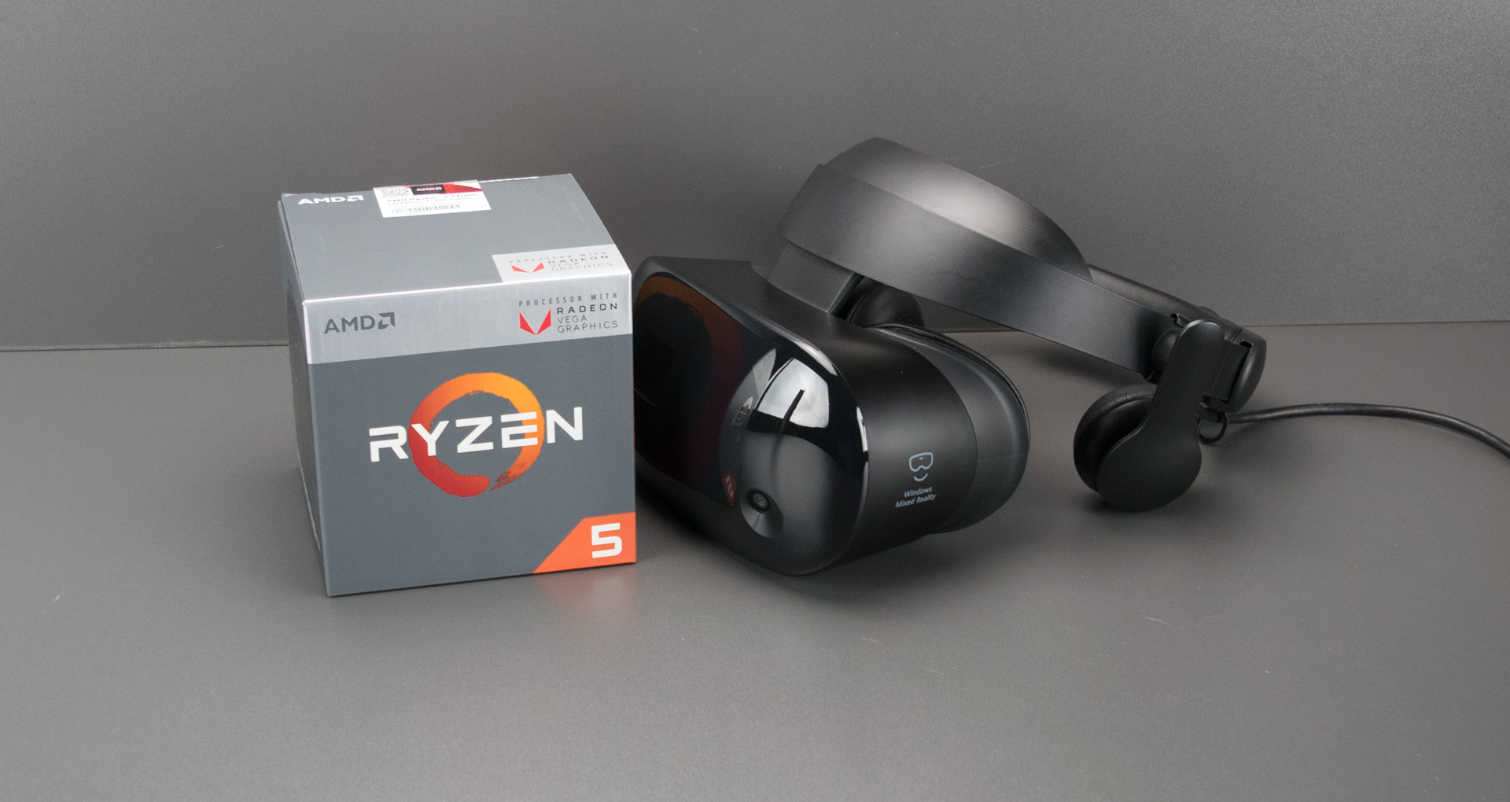A Budget VR Option? Testing AMD's Ryzen 5 2400G With Windows Mixed Reality
AMD Ryzen Proves VR on Integrated Graphics Isn’t Far Off
In mid February of 2018, AMD released the first two Ryzen desktop processors with integrated Vega graphics. As we saw in testing, the Ryzen 3 2200G and the Ryzen 5 2400G deliver impressive performance for budget gaming. Both are capable of delivering impressive 720p performance in modern games (for integrated graphics silicon), and passable 1080p performance in somewhat older titles. It’s fair to say that AMD’s first round of so-called "Raven Ridge" processors live up to the expectations that AMD set for these budget-friendly parts. We’ve already demonstrated their traditional gaming capabilities, but we wanted to know if these chips could handle something a little bit more immersive--namely virtual reality.
To be clear, the Raven Ridge processors fall far short of the necessary performance threshold for the Oculus Rift and the HTC Vive platforms. In fact, the chips' VR gaming performance is so poor that we didn’t even include VR Mark results in their respective reviews. Indeed, we have no delusions about running one of those headsets with AMDs integrated graphics--at least, not this generation. However, the performance threshold for Microsoft’s Windows Mixed Reality platform is much lower.
Microsoft’s Windows Mixed Reality (which in its current form is really just VR by another name) demands the lowest system requirements of any desktop/laptop VR platform currently on the market. And that's important in these days of expensive RAM and even more expensive high-end graphics cards. The HTC Vive requires a minimum of an Nvidia GeForce GTX 970 or AMD Radeon R9 290, and the Oculus Rift supports cards that rank as low as the GTX 960/GTX 1050 Ti from Nvidia or the RX 470 from AMD. By contrast, Microsoft’s Windows Mixed Reality “Ultra” specification calls for GPUs from a tier lower, such as Nvidia’s GTX 1050 or AMD’s RX 460 cards. The Vega GPU cores in our Raven Ridge chip are no comparison for most of the GPUs mentioned above. However, Microsoft also offers a lower spec option with WMR that works with Intel’s HD Graphics 620 integrated graphics. The low spec option doesn’t support many games, but it does offer an immersive productivity environment, and that’s the experience we’re after--at least for starters.
Microsoft doesn’t yet officially support AMD’s Ryzen processors with Vega graphics for mixed reality. However, the performance potential of the Ryzen 5 2400G far surpasses that of Intel's integrated HD Graphics 620 silicon, which is expressly supported. Despite not having an official nod from Microsoft, we wanted to find out first-hand: Can a system powered by a Ryzen 5 2400G run a Windows Mixed Reality HMD to any reasonable degree?
On the Intel side, Microsoft worked closely with the company to ensure that 6th, 7th, and 8th generation Intel Core i processors with integrated graphics would be able to drive the Windows MR headsets, but Microsoft had to cut serious corners to make it work. Intel’s HD Graphics 620 can’t reliably deliver the 90 frames per second (fps) that's been the standard smooth VR for a while now. So the Windows MR headsets operate at a lower 60Hz refresh rate when powered by Intel's integrated graphics. We suspected that the extra graphics capability of AMD’s Ryzen G processors could deliver a better Window MR experience than Intel’s integrated graphics, but there was only one way to find out. So we gathered some parts together and started building and testing.
MORE: Best Virtual Reality Headsets
MORE: All Virtual Reality Content
Get Tom's Hardware's best news and in-depth reviews, straight to your inbox.
MORE: Virtual Reality Basics
Current page: AMD Ryzen Proves VR on Integrated Graphics Isn’t Far Off
Next Page VR on Integrated Graphics - Our Methodology and Test HardwareKevin Carbotte is a contributing writer for Tom's Hardware who primarily covers VR and AR hardware. He has been writing for us for more than four years.
-
dudmont Did you do any overclocking or tweaking of the memory on the systems? IIRC, raven ridge really benefits from both. Would it benefit enough to make any serious difference in feel or allow you to run slightly higher graphical detail settings? I know not everyone spends hours fine tuning, but AMD chips beg it.Reply -
Heliosurge Awesome Review! I agree completely. If AMD continues on this path with apu improvements will definitely help to propel vr into the mainstream. Definitely look forward to seeing their future line up & how it compares.Reply -
kcarbotte Reply20813194 said:Did you do any overclocking or tweaking of the memory on the systems? IIRC, raven ridge really benefits from both. Would it benefit enough to make any serious difference in feel or allow you to run slightly higher graphical detail settings? I know not everyone spends hours fine tuning, but AMD chips beg it.
I did not do any overclocking for this article. Mostly due to time constraints -- I only had two weeks with the CPU before it had to go back.
I also didn't spend any time trying to tweak the memory beyond 2933MHz because the memory that I have is from before Ryzen chips hit the market and it doesn't like to run at 3200MHz on my X370 boards.
That said, I don't think you would get enough of a gain from a modest overclock to make much of a difference.
30 FPS really isn't good enough for VR games. You can get by with it if you have strong VR legs, but its not something I would recommend trying.
This article is really just an experiment to set the tone of the current state of affairs. Wait a year or two and we'll probably be having a completely different discussion. -
Plumboby Give AMD a few months drivers will get better they are doing drivers atm to suit the Apu as we speak as driver wise is lucky dip. THink about it new tech new aritecture new bugs new problems to iron out give them a few moths to iron out the kinks & markets to stabilise a bit & I suggest that With the Ryzen 2s coming out they probly going do a mass driver Bios, motherboard hit out to suit any issues. I know off hand that they are currently beefing up the drivers with odd glitches that have filtered threw being a new Apu.Reply -
ZRace Great little review, I didn't expect the APU to drive such high resolutions in VR that well.Reply -
Rookie_MIB Imagine if AMD put together a custom APU with 20 CU's.... That would make for almost (I think) a near 60fps experience. That would be a VERY usable VR chip.Reply -
kcarbotte Reply20813544 said:Great little review, I didn't expect the APU to drive such high resolutions in VR that well.
Haha, thanks!
Nor did I! -
nate1492 How low are your standards for passable VR? How does 20-30 FPS in *FRUIT NINJA* get anything but laughed out the building?Reply
Do you want to get sick while playing VR? This is how you get sick playing VR.
To be clear. If you bought this CPU and a VR headset, there is a *very strong chance you would be ill while playing this*.
This review barely touches on this fact. It's hard enough to not feel ill below 60 or 90 FPS, but 20-30 with high frame latency will feel awful. -
Nino LS Did you skip over the section where native WMR titles ran excellent? "It managed to run Halo Recruit with ease." They did not recommend this chip for SteamVR, where all the lower frame rates you cite happened. The point is an APU is running modern VR and running it well in it's native ecosystem - this is great news for all VR users .....and those that don't even know they will be using it yet.Reply -
kcarbotte Reply20814745 said:How low are your standards for passable VR? How does 20-30 FPS in *FRUIT NINJA* get anything but laughed out the building?
Do you want to get sick while playing VR? This is how you get sick playing VR.
To be clear. If you bought this CPU and a VR headset, there is a *very strong chance you would be ill while playing this*.
This review barely touches on this fact. It's hard enough to not feel ill below 60 or 90 FPS, but 20-30 with high frame latency will feel awful.
I didn't at any point recommend using an APU for Steam VR. I clearly stated we used those games for benchmarks because you can't run FCAT VR in the Windows MR environment.
30 fps is not passable VR, but it exceeded my expectations.

